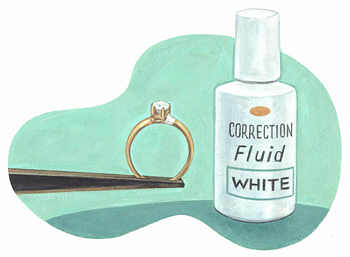Avoiding Melting Soldered Seams
Soldering is a delicate and sometimes difficult process especially when you need to solder very close to a previous solder seam. Without extra care, you can easily melt that prior seam and dislodge the parts. One solution is to drop down a temperature level for the second seam.
1 Minute Read
Soldering is a delicate and sometimes difficult process - especially when you need to solder very close to a previous solder seam. Without extra care, you can easily melt that prior seam and dislodge the parts.
One solution is to drop down a temperature level for the second seam, but that will limit further soldering to even lower temperatures. Another reason for staying with higher-temperature solders is that the color of lower-melting-point solder usually does not match the metal as well. Fortunately, there are other ways to deal with multiple solderings in close quarters, which enable you to work at the same solder level.
Remember that solder flows only on clean surfaces; it doesn't work well on dirty or oxidized areas, nor on surfaces that don't have flux (a cleaning compound). So you can discourage seams from flowing by intentionally making them dirty. A good way to do that is with an anti-flux, such as yellow ochre, rouge, grease, or even melted rubber; all of these compounds inhibit solder flow.
However, one tangible technological benefit for bench jewelers is correction fluid, the kind used in offices all over the world. Coming with its own applicator in a jeweler's size bottle, this solution significantly decreases solder flow.
Note: Water-based correction fluids are less toxic than those that are solvent based. In any event, after applying the liquid, let it air dry in a well ventilated area, and do not inhale the fumes. By applying correction fluid to previously soldered joints, you can solder additional seams nearby and still maintain the integrity of the piece.
The award-winning Journal is published monthly by MJSA, the trade association for professional jewelry makers, designers, and related suppliers. It offers design ideas, fabrication and production techniques, bench tips, business and marketing insights, and trend and technology updates—the information crucial for business success. “More than other publications, MJSA Journal is oriented toward people like me: those trying to earn a living by designing and making jewelry,” says Jim Binnion of James Binnion Metal Arts.
Click here to read our latest articles
Click here to get a FREE four-month trial subscription.
You assume all responsibility and risk for the use of the safety resources available on or through this web page. The International Gem Society LLC does not assume any liability for the materials, information and opinions provided on, or available through, this web page. No advice or information provided by this website shall create any warranty. Reliance on such advice, information or the content of this web page is solely at your own risk, including without limitation any safety guidelines, resources or precautions, or any other information related to safety that may be available on or through this web page. The International Gem Society LLC disclaims any liability for injury, death or damages resulting from the use thereof.
The All-In-One Jewelry Making Solution At Your Fingertips
When you join the Ganoksin community, you get the tools you need to take your work to the next level.
Trusted Jewelry Making Information & Techniques
Sign up to receive the latest articles, techniques, and inspirations with our free newsletter.



